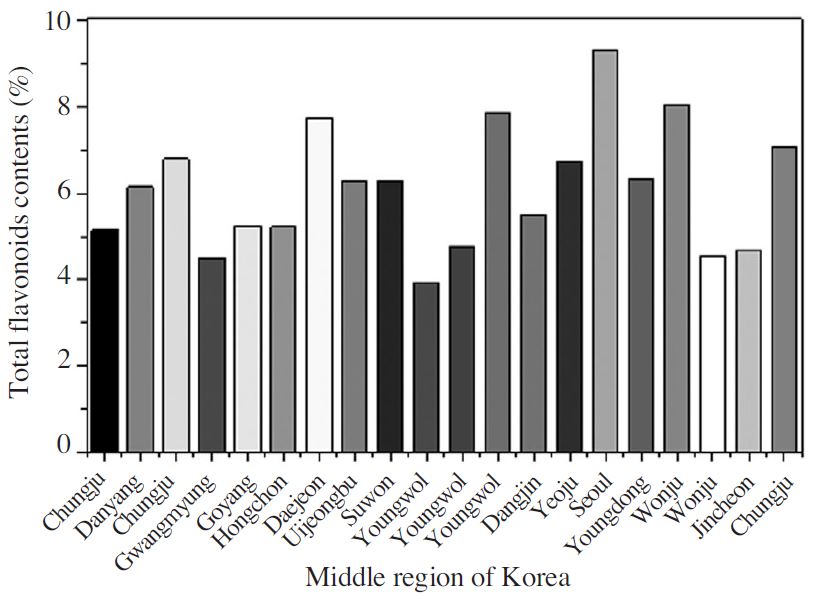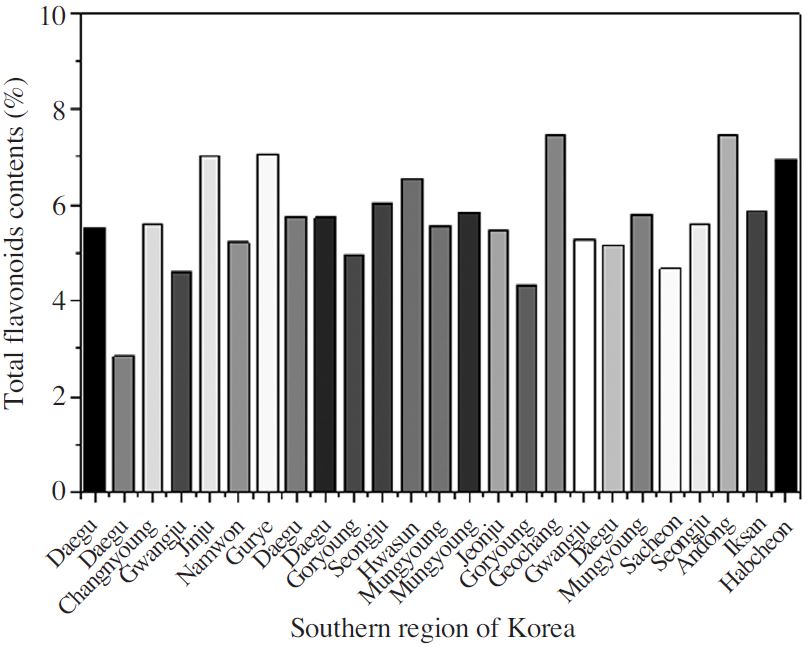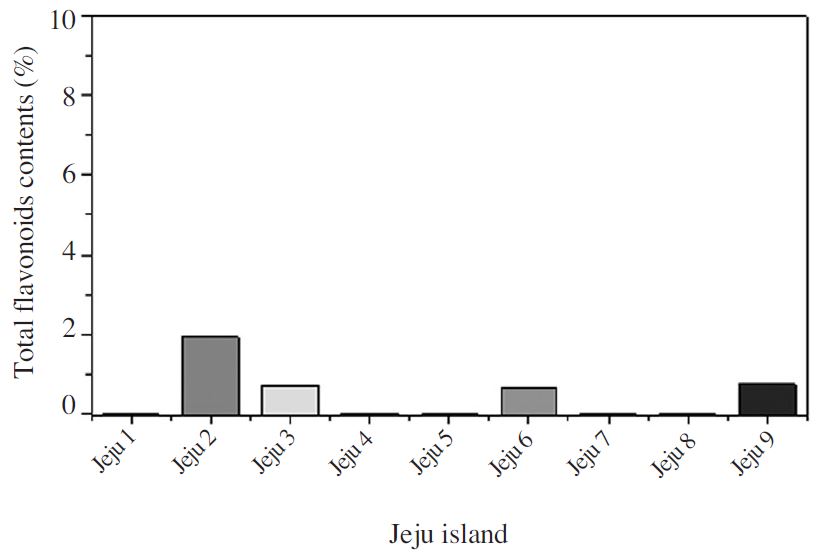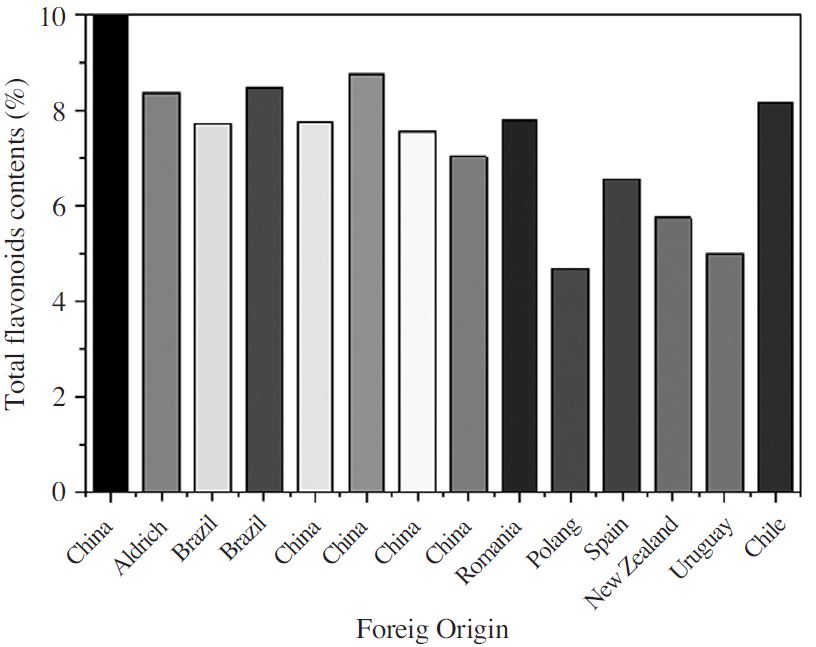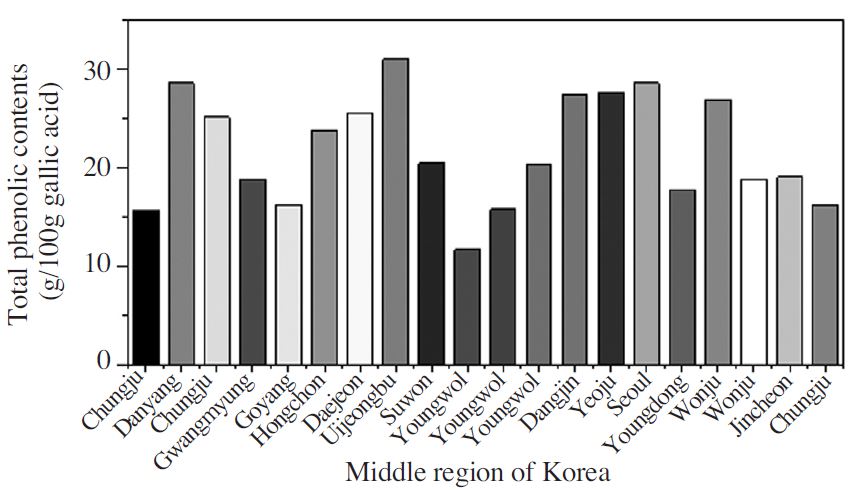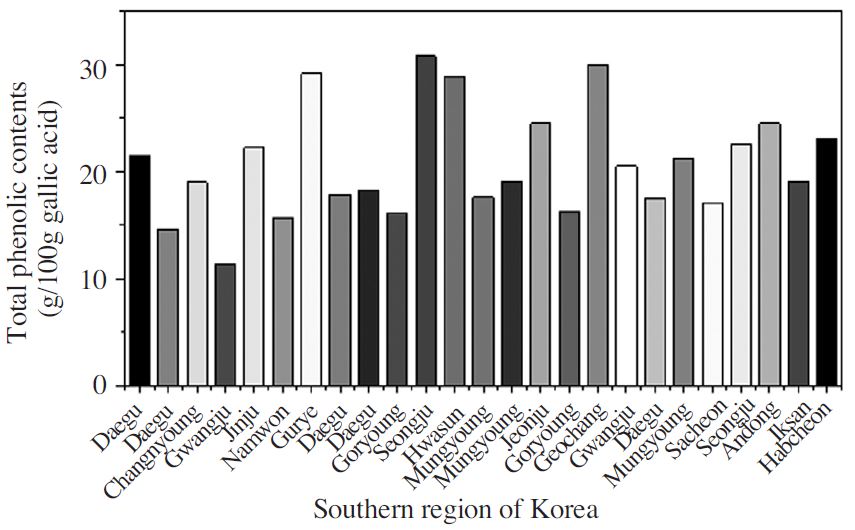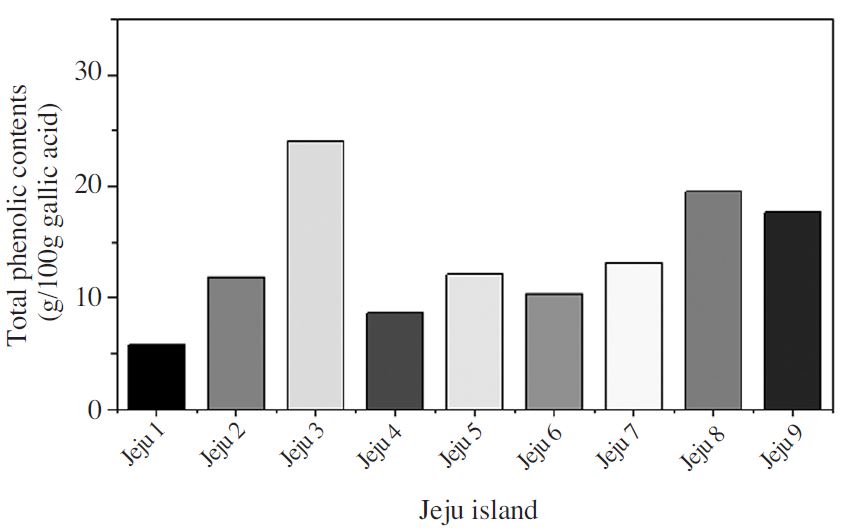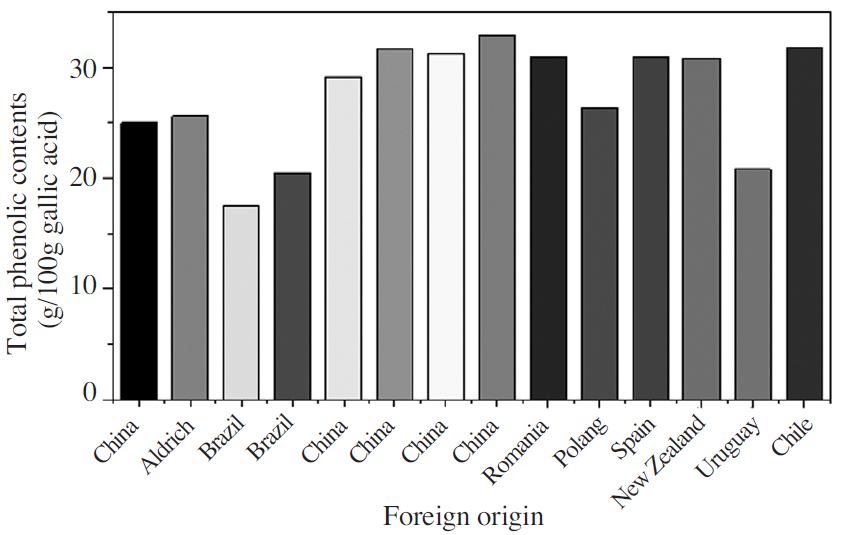
국내산 프로폴리스의 총플라보노이드 및 총페놀함량 비교
Abstract
Propolis is a sticky material like resin made from plant growing point which are collected by bees, then mixed with bee saliva enzyme. It is used to keep bee colony safe by applying inside of bee hive. The propolis, it is necessary to extract the active ingredient in raw material, mainly extracted by the ethyl alcohol. Ethanol extracted propolis collected from different regions in Korea, we compared the total flavonoids and total phenolic contents. The average of total flavonoids content of propolis were 6.1% in central regions, 5.7% in southern regions, however, propolis in Jeju island represented the average value of 0.44%. The other areas showed a value of 7.4%. The total phenolic contents of propolis were 21.8% in the central region, 20.9% in southern regions, 13.7% in Jeju, and the other areas showed a value of 29.4%. Although some differences depending on the region, the propolis produced in Korea has been as the substance that is rich in flavonoids and phenolics.
Keywords:
Korean propolis, Total flavonoid contents, Total phenolic contents서 론
프로폴리스는 꿀벌들이 수목류의 생장점 보호 물질이나 진액을 수집, 타액과 혼합하여 만드는 암갈색 등 여러 가지 색을 띄는 끈적끈적한 교질성 물질이며, 벌통에 침입한 것들의 잔해를 부패하지 않게 하기 위하여 사용되어지고, 벌통 내의 미생물들의 성장도 억제시키는 것으로 알려지고 있어, propolis는 자연이 주는 신비의 천연항생물질이라고 말할 수 있다(Ghisalberti, 1979). 프로폴리스는 동구권에서 민간의 약품으로 널리 이용되고 있는 점 등으로 미루어 볼 때, 금후 국내산 프로폴리스에 대하여 충분한 연구 가치가 있을 것으로 기대되어지며, 아울러 국내에서도 점차 활발한 연구 분위기 확산뿐만 아니라 다양한 소재 개발에 관한 관심이 고조되고 있다. 프로폴리스는 pro는 방어를 위해서, polis는 도시라는 의미로 도시 앞에 있으면서 도시전체를 안전하게 지킨다는 뜻이며, 벌집이 가득한 봉군을 안전하게 지키는 물질을 뜻하는 그리스어이다.
프로폴리스는 수집원이 되는 식물의 종류와 계절에 따라 다르기 때문에 200가지 이상의 구성물질을 함유하고 있다(Ghisalberti, 1979; Greenaway et al., 1991; Marcucci, 1995; Bankova et al., 2000; Pietta et al., 2002; Kumazawa et al., 2004; Isla et al., 2005; Silici and Kutluca, 2005; Gomez-Caravaca et al., 2006; Mohammadzadeh et al., 2007; Jasprica et al., 2007; Alencar et al., 2007).
페놀성 화합물, 플라보노이드 들은 강한 항산화 효과를 나타내며, 프로폴리스에서 페놀성 화합물과 항산화 효과의 연관성에 대한 다수의 연구들이 있다(Bors et al., 1990; Heim et al., 2002; Russo et al., 2002; Kumazawa et al., 2004), 이런 활성들은 페놀화합물과 수지상 물질들의 복합작용에 의해 상승효과를 갖는 것으로 보고되고 있다(Burdock, 1998; Markham et al., 1996).
프로폴리스를 이용하기 위하여는 원괴 상태에서 유효성분을 추출하는 것이 필요하며, 주로 알콜에 의하여 추출하고 있다(Woo et al., 2015). 알콜 추출물에 대하여 국내외 여러 지역에서 채집한 프로폴리스에 대하여 총플라보노이드 함량과 총페놀 함량을 비교해 보고자 한다. 중부 23지역, 남부 29지역, 제주 9지역, 기타 9지역 등 70지역의 프로폴리스를 수집하였다. 수집된 프로폴리스에 대하여 총플라보노이드 함량과 총페놀함량을 측정하였다.
재료 및 방법
프로폴리스의 수집 및 추출
프로폴리스 시료는 국내외 양봉 농가로부터 수집하였으며, 총플라보노이드, 총페놀함량 분석을 위하여 에탄올 80% 용액에서 48시간 추출하여 농축시켜 사용하였다.
총플라보노이드 함량 분석(식품공전법)
농축한 프로폴리스 추출물 0.1g을 칭량하고 90% 에탄올 20ml를 가해 용해, 원심분리(3,000rpm, 10min)한다. 상등액을 취하고 잔류물을 80% 에탄올 8ml로 3회 추출하고 전 추출액을 합하여 80% 에탄올을 사용하여 전량을 50ml로해서시험용액으로한다.
시험용액 0.5ml를 시험관에 취하고 에탄올 1.5ml, 10% 질산알루미늄용액 0.1ml, 1M 초산칼륨용액 0.1ml, 물 2.8ml를 가하여 충분히 교반을 한다. 실온에서 40분간 정치 후 액층을 10mm 셀을 사용하여 물을 대조액으로 하여 415nm에서 흡광도를 측정한다. 시료의 흡광도로부터 별도로 상기 조작 중 질산알루미늄용액 대신 물 0.1ml를 가한 것의 흡광도를 뺀 흡광도 차를 이용하여 쿼르세친을 이용하여 작성한 검량선에 의거 총플라보노이드 a(%)를 산출하였다.
| 총플라보노이드함량 |
총페놀 함량분석
총페놀 함량은 Folin-Ciocalteau 방법(Kuyala et al., 2000)을 변형하여, 시료용액 0.5ml (80% ethanol 추출용액, 3반복)에 1N Folin-Ciocalteau 용액 0.5ml를 넣고, 10% Na2CO3 용액 0.5ml를 넣어 50분 동안 정치 후 10분동안 150g에서 원심 분리하였다.
그 상등액 을 760nm의 파장에서 UV/VIS Spectrophotometer(Perkin-Elmer Lambda 10)로 측정하였다. 총페놀함량은 몰식자산(gallic acid)을 이용하여 작성한 검량선에 의거 %(g/100g gallic acid)로 나타내었다.
결과 및 고찰
프로폴리스 수집지역에 따른 총플라보노이드 함량
우리나라 전역에서 생산된 프로폴리스를 추출하여 총플라보노이드함량을 확인하였다. 그 결과 중부지역(경기도, 강원도, 충청북도, 충청남도)에서 생산된 프로폴리스는 4.0~9.3%의 범위로 평균 6.1%의 값을 나타내었으며(Fig. 1), 그 중 서울에서 수집한 프로폴리스에서 가장 높은 값인 9.3%를 나타내었다.
남부지역(전라남도, 전라북도, 경상남도, 경상북도)에서 생산된 것은 2.8~7.8%의 범위로 평균 5.7%의 값을 나타내는 것(Fig. 2)으로 확인되었다. 그 중 대전에서 수집한 프로폴리스가 가장 높은 값을 나타내었다. 그러나, 제주도에서 생산된 프로폴리스의 경우 0~1.9%의 값을 나타내었으며, 5개의 시료에서 0%의 값을 나타내었다. 제주산 프로폴리스는 2%이하의 값을 나타냄으로서 프로폴리스의 건강기능식품의 원료로서 규격에 적합하지 못하는 것으로 나타났다(Fig. 3). 해외에서 수집한 프로폴리스는 4.7~10%의 범위를 나타내었다(Fig. 4). 국내에서 생산된 프로폴리스는 Kumazawa 등(2010)이 보고한 아르헨티나산 프로폴리스와 유사한 결과를 나타내었다.
프로폴리스 수집지역에 따른 총페놀함량
우리나라 전역에서 생산된 프로폴리스를 추출하여 총페놀함량을 확인하였다. 그 결과 중부지역에서 생산된 프로폴리스는 12~31%의 범위로 평균 22%의 값을 나타내었으며(Fig. 5), 그 중 의정부에서 수집한 프로폴리스가 31%로 가장 높은 값을 나타내었다. 남부지역에서 생산된 것은 11~31%의 범위로 평균 21%의 값을 나타내는 것(Fig. 6)으로 확인되었으며, 그 중 성주에서 수집한 프로폴리스에서 가장 높은 값을 나타내었다. 그러나, 제주도에서 생산된 프로폴리스의 경우 6~24%의 범위로 평균 14%의 값을 나타내었으며(Fig. 7), 이는 다른 지역에서 수집한 프로폴리스보다 30%이상 낮은 값을 나타내었다. 해외에서 수집한 프로폴리스는 18~33%의 범위를 나타내었으며(Fig. 8), 평균 29%의 값을 나타내었다. 이는 생산된 지역에 따라 차이가 나타나고 있으나, 제주도를 제외한 다른 지역에서는 비슷한 경향을 나타내었다.
이 연구에서 총플라보노이드함량과 총페놀함량을 확인하기 위하여 질산알루미늄 발색법과 Folin-Coicalteu법을 이용하였다. 이들 측정방법은 다양한 프로폴리스 시료가 많은 폴리페놀을 함유하는 것을 잘 평가해 준다고 할 수 있다.
적 요
프로폴리스는 꿀벌들이 수목류의 생장점 보호 물질이나 진액을 수집, 타액과 혼합하여 만드는 암갈색 등 여러 가지 색을 띄는 끈적끈적한 점착성 물질이며, 벌통에 침입한 것들의 잔해를 부패되지 않도록 사용 되어지는 물질로, 벌통 내의 미생물들의 성장도 억제시키는 물질로 알려지고 있다. 이런 프로폴리스를 이용하기 위하여는 원괴상태에서 유효성분을 추출하는 것이 필요하며, 주로 알콜에 의하여 추출하고 있다. 알콜 추출물에 대하여 국내 여러 지역에서 채집한 프로폴리스에 대하여 총플라보노이드 함량과 총페놀 함량을 비교해 보고자 하였다. 프로폴리스의 총플라보노이드함량은 중부지역이 6.1%, 남부지역이 5.7%, 제주지역이 0.44%의 평균값을 나타내었으며, 해외에서 수집한 프로폴리스는 7.4%의 값을 나타내었다. 국내에서는 내륙지역에서는 지역 간에 큰 차이가 없으나, 제주 지역은 차이를 나타내었으며, 해외에서 수집된 프로폴리스는 높은 값을 나타내었다. 이는 주변에 분포하는 수목의 특성에 따라 많은 차이가 나타나기도 하고, 원괴의 품질에서도 많은 영향을 미치는 것으로 확인되었다. 프로폴리스의 총페놀함량을 측정해본 결과, 중부지역은 22%, 남부지역은 21%, 제주지역은 14%, 기타 다른지역은 29.4%의 값을 나타내었다. 이런 결과로, 지역에 따라 약간의 차이는 있지만, 프로폴리스는 플라보노이드류와 페놀류가 많이 함유되어 있는 물질로 확인되었다.
Acknowledgments
본 연구는 농촌진흥청 국립농업과학원 어젠다 연구개발사업(과제번호 PJ010912)의 지원에 의해 수행되었음.
Reference
-
Ahn, M. R., S. Kumazawa, T. Hamasaka, K. S. Bang, and T. Nakayama, (2004), Antioxidant activity and constituents of propolis collected in various areas of Korea, J. Agr. Food Chem, 52, p7286-7292.
[https://doi.org/10.1021/jf048726s]

-
Alencar, S. M., T. L. C. Oldoni, M. L. Castro, I. S. R. Cabral, C. M. Costa Nieto, J. A. Cury, P. L. Rosalen, and M. Ikegaki, (2007), Chemical composition and biological activity of a new type of Brazilian propolis: red propolis, J. Ethnoph, 113, p278-283.
[https://doi.org/10.1016/j.jep.2007.06.005]

-
Bankova, V. S., S. L. De Castro, and M. C. Marcucci, (2000), Propolis: recent advances in chemistry and plant origin, Apidologie, 31, p3-15.
[https://doi.org/10.1051/apido:2000102]

-
Bors, W., W. Heller, C. Michel, and M. Saran, (1990), Flavonoids as antioxidants: determination of radical scavenging efficiencies, Meth. Enzymol, 186, p343-355.
[https://doi.org/10.1016/0076-6879(90)86128-I]

-
Burdock, G. A., (1998), Review of the biological properties and toxicity of bee propolis, Food Chem. Toxicol, 36, p347-363.
[https://doi.org/10.1016/S0278-6915(97)00145-2]

-
Ghisalberti, E. L., (1979), Propolis: a review, Bee World, 60, p59-84.
[https://doi.org/10.1080/0005772X.1979.11097738]

-
Gomez Caravaca, M., M. Gomez Romero, D. Arraez Roman, A. Segua Carretero, and A. Fernandez Gutierrez, (2006), Advances in the analysis of phenolic compounds in products derived from bees, J. Pharm. Bio. Anal, 41, p1220-1234.
[https://doi.org/10.1016/j.jpba.2006.03.002]

- Greenaway, W., J. May, T. Scaysbrook, and F. R. Whatley, (1991), Identification by gas chromatography mass spectrometry of 150 compounds in propolis, Zeitschrift fur Naturforschung, Teil C 46, p111-121.
-
Heim, K. E., A. R. Tagliaferro, and D. J. Bobilya, (2002), Flavonoids antioxidants: chemistry, metabolism and structure activity relationship, J. Nutr. Biochem, 13, p572-584.
[https://doi.org/10.1016/s0955-2863(02)00208-5]

-
Isla, M. I., J. F. Paredes Guzman, M. I. Nieva Moreno, H. Koo, and Y. K. Park, (2005), Some chemical composition and biological activity of northern Argentine propolis, J. Agr. Food Chem, 53, p1166-1172.
[https://doi.org/10.1021/jf040130h]

-
Jasprica, I., M. Bojic, A. Mornar, E. Besic, K. Bucan, and M. Medic Saric, (2007), Evaluation of antioxidative activity of Croatian propolis samples using DPPH and ABTS stable free radical assays, Molecules, 12, p1006-1021.
[https://doi.org/10.3390/12051006]

-
Kujala, T. S., J. M. Loponen, K. D. Klika, and K. Pihlaja, (2000), Phenolics and Betacyanins in Red Beetroot (Beta vulgaris) Root: Distribution and Effect of Cold Storage on the Content of Total Phenolics and Three Individual Compounds, J. Agr. Food Chem, 48, p5338-5342.
[https://doi.org/10.1021/jf000523q]

-
Kumazawa, S., M. R. Ahn, T. Fujimoto, and M. Kato, (2010), Radical scavenging activity and phenolic constituents of propolis from different regions of Argentina, Natural Product Research, 24(9), p804-812.
[https://doi.org/10.1080/14786410802615270]

-
Kumazawa, S., T. Hamasaka, and T. Nakayama, (2004), Antioxidant activity of propolis of various geographic origins, Food Chemistry, 84, p329-339.
[https://doi.org/10.1016/S0308-8146(03)00216-4]

-
Marcucci, M. C., (1995), Propolis: chemical composition, biological properties and therapeutic activity, Apidologie, 26, p83-99.
[https://doi.org/10.1051/apido:19950202]

-
Markham, K. R., K. A. Mitchell, A. L. Wilkins, J. A. Daldy, and Y. Lu, (1996), HPLC and GC MS identification of the major organic constituents in New Zealand propolis, Phytochemistry, 42, p205-211.
[https://doi.org/10.1016/0031-9422(96)83286-9]

-
Mohammadzadeh, S., M. Shariatpanahi, M. Hamedi, R. Ahmadkhaniha, N. Samadi, and S. Nasser Ostad, (2007), Chemical composition, oral toxicity and microbial activity of Iranian propolis, Food Chem, 103, p1097-1103.
[https://doi.org/10.1016/j.foodchem.2006.10.006]

-
Pietta, P. G., C. Bardana, and A. M. Pietta, (2002), Analytical methods for quality control of propolis, Fitoterapia, 73, pS7-20.
[https://doi.org/10.1016/S0367-326X(02)00186-7]

-
Russo, A., R. Longo, and A. Vanella, (2002), Antioxidant activity of propolis: role of caffeic acid phenethyl ester and galangin, Fitoterapia, 73, pS21-S29.
[https://doi.org/10.1016/S0367-326X(02)00187-9]

-
Silici, S., and S. Kutluca, (2005), Chemical composition and antibacterial activity of propolis collected by three different races of honeybees in the same region, J. Ethnopharcology, 99, p69-73.
[https://doi.org/10.1016/j.jep.2005.01.046]

-
Woo, S. O., I. P. Hong, and S. M. Han, (2015), Extraction properties of propolis with ethanol concentration, J. Apiculture, 30(3), p211-216.
[https://doi.org/10.17519/apiculture.2015.09.30.3.211]


